
DIpil Das
Introduction
The coronavirus pandemic has accelerated the already fast growth of US retail e-commerce sales. As a result, brands are investing in, and expanding, their e-commerce businesses to better serve today’s increasingly channel-agnostic and demanding shopper. Consumers are researching and purchasing products across several channels, from marketplaces to social media. Social media has quickly become an important avenue of commerce, as a medium for both research and purchasing. Social commerce sales in the US are expected to grow by $7.3 billion in 2020—33% year over year—and continue growing at a similar rate through 2024, according to TechNavio. Coresight Research’s late-2019 survey of 1,509 US Internet users found that 57% of US shoppers use social media as a part of their shopping process, even if they do not always make purchases directly through social platforms. Small and medium-size brands often struggle to find cost-effective and efficient ways to fulfill online orders—an issue that is compounded by today’s complex ecosystem of digital shopping channels. Poor inventory management and high delivery costs can cause revenue-draining friction in the online consumer journey. Delivery-speed expectations are high, and cart abandonment rates due to shipping fees continue to rise. To fulfill the desires of consumers across multiple shopping avenues, brands must ensure that they can rely on a strong, smart inventory management and fulfillment system. In this report, we examine the current pain points and areas of opportunity for brands to improve the reach and efficiency of their online businesses. We also discuss how Project Verte’s end-to-end e-commerce solutions can enable brands to optimize their digital presence and streamline their fulfillmentChallenges in the Shifting E-Commerce Landscape
Coresight Research projects that e-commerce will grow by 31% in 2020, making it more vital than ever for brands to ensure the quality of the online customer journey. We begin by outlining two areas in which brands face challenges when competing for the attention and dollars of today’s online shoppers:- Reaching the channel-agnostic consumer across multiple devices and selling platforms
- Optimizing fulfillment to reduce costs and purchase friction
- Social commerce
- Diversifying sales channels
- Retail drop shipping
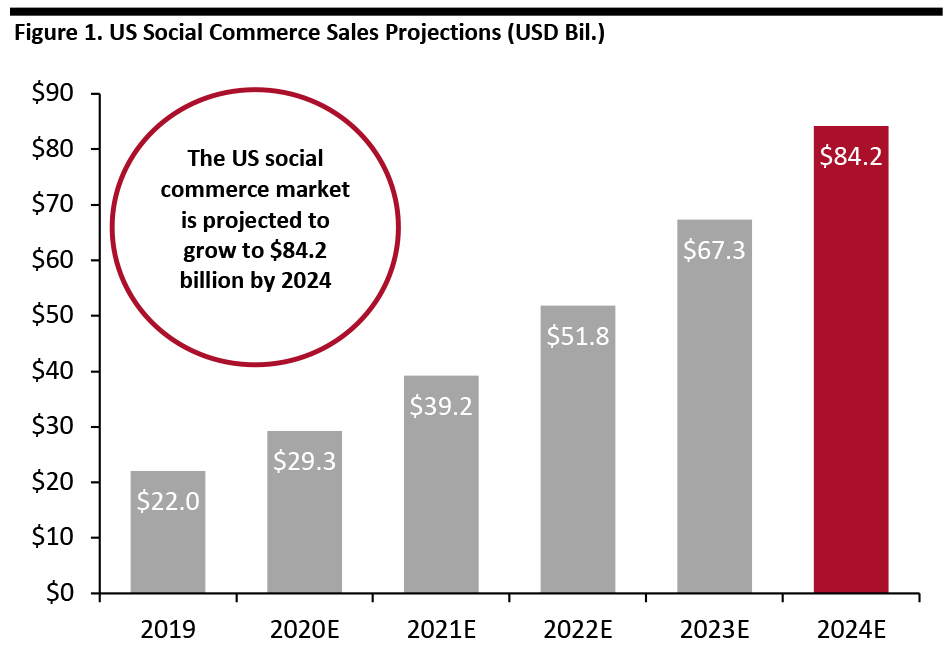 Source: TechNavio[/caption]
Brands are increasingly using social media as a method of driving consumer traffic to their owned online stores. Different social media sites drive sales in different ways. On Instagram, for instance, influencers can post sponsored photos or videos, including a brand’s link in the caption or tagging the brand in their content. Other social media sites, such as Reddit, enable users to create forums discussing certain topics, such as “Men’s Fashion Sales,” and post links to relevant webpages on these discussion boards. The combined influence of these social networks can drive a significant amount of a brand’s total website traffic. The US website of sustainable shoe brand Allbirds, for example, draws 6.2% of its traffic from social media, according to the website analytics provider SimilarWeb.
To fully capitalize on the growth of social commerce, brands must reduce friction in the purchase journey. According to our survey, 77.6% of US consumers who utilize social media platforms as part of the shopping process said that they would “occasionally” or “often” abandon a purchase because of a lack of built-in functionality. Streamlined social shopping experiences will likely become a necessity for all brands looking to compete in the increasingly diverse e-commerce space.
Diversifying Sales Channels
Online marketplaces, such as Amazon and Walmart.com, have seen continued growth during the pandemic, and are now routinely the first place many consumers go to shop. Two-thirds of US consumers typically start their search for new products on Amazon, according to the e-commerce company’s 2019 Consumer Behavior Report. That same report also found that 89% of US consumers are more likely to buy on Amazon than any other e-commerce site. Consumers are drawn to Amazon’s ability to provide strong product visibility and fast fulfillment options. Even prior to the pandemic, a Statista survey revealed that 85% of US consumers had made a purchase on Amazon within the past 12 months, as shown in Figure 2.
[caption id="attachment_120137" align="aligncenter" width="700"]
Source: TechNavio[/caption]
Brands are increasingly using social media as a method of driving consumer traffic to their owned online stores. Different social media sites drive sales in different ways. On Instagram, for instance, influencers can post sponsored photos or videos, including a brand’s link in the caption or tagging the brand in their content. Other social media sites, such as Reddit, enable users to create forums discussing certain topics, such as “Men’s Fashion Sales,” and post links to relevant webpages on these discussion boards. The combined influence of these social networks can drive a significant amount of a brand’s total website traffic. The US website of sustainable shoe brand Allbirds, for example, draws 6.2% of its traffic from social media, according to the website analytics provider SimilarWeb.
To fully capitalize on the growth of social commerce, brands must reduce friction in the purchase journey. According to our survey, 77.6% of US consumers who utilize social media platforms as part of the shopping process said that they would “occasionally” or “often” abandon a purchase because of a lack of built-in functionality. Streamlined social shopping experiences will likely become a necessity for all brands looking to compete in the increasingly diverse e-commerce space.
Diversifying Sales Channels
Online marketplaces, such as Amazon and Walmart.com, have seen continued growth during the pandemic, and are now routinely the first place many consumers go to shop. Two-thirds of US consumers typically start their search for new products on Amazon, according to the e-commerce company’s 2019 Consumer Behavior Report. That same report also found that 89% of US consumers are more likely to buy on Amazon than any other e-commerce site. Consumers are drawn to Amazon’s ability to provide strong product visibility and fast fulfillment options. Even prior to the pandemic, a Statista survey revealed that 85% of US consumers had made a purchase on Amazon within the past 12 months, as shown in Figure 2.
[caption id="attachment_120137" align="aligncenter" width="700"]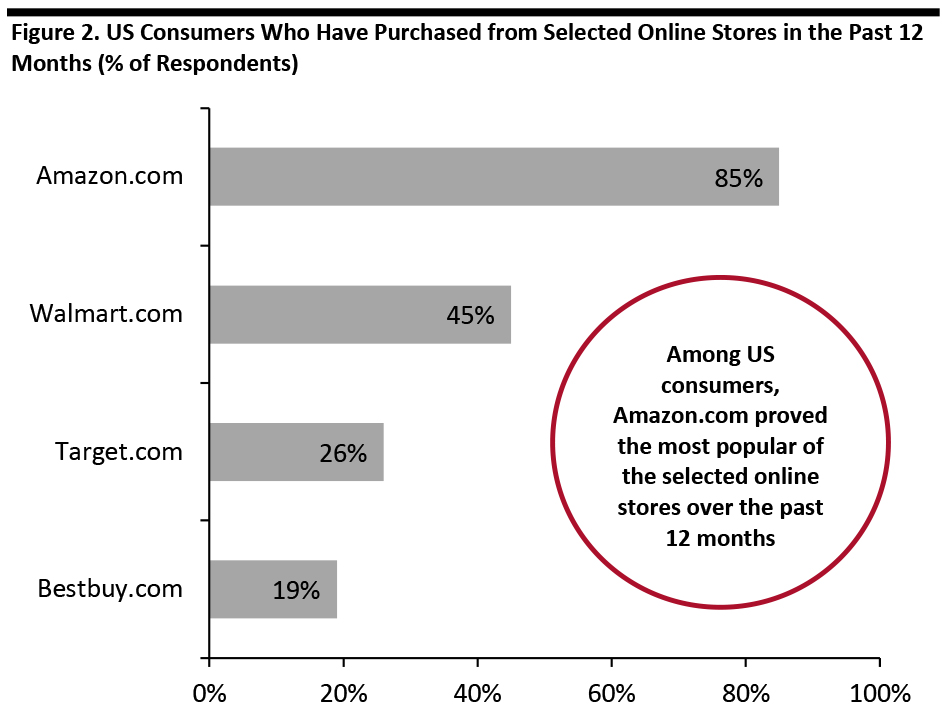 Source: Statista[/caption]
Walmart, which reported 97% e-commerce growth in its most recent quarter, ended July 31, 2020, has emerged as significant player in the US e-commerce market. Like Amazon, Walmart now operates a marketplace for third-party sellers on its website in addition to selling its own products. It has also introduced a subscription-based service, Walmart+, which gives shoppers free, often same-day delivery on Walmart and marketplace products. Many brands will feel compelled to go where shoppers are and thus establish a presence on these rapidly growing major e-commerce platforms.
However, it is also vital that brands take a holistic approach to their online selling. Brands can create more personalized and unique experiences on their owned websites, and can use multiple sales platforms to reach consumers that might not otherwise find them on Amazon or Walmart. While these online marketplaces have become too pervasive for all but the largest brands in the world not to work with, brands can benefit from expanding to other online channels in addition to their presence on Amazon and Walmart.
NIKE is perhaps the most notable example of a brand that has focused on its non-marketplace sales in recent times. In November 2019, NIKE announced that it would not sell directly to Amazon anymore, instead focusing on “elevating consumer experiences through more direct, personal relationships,” according to a company spokesperson cited by CNBC. So far, the strategy appears to be working: NIKE’s most recent earnings report (for its quarter ended August 31) cited a 12% rise in NIKE direct sales and an 82% rise in overall NIKE brand digital sales. NIKE has enough existing brand recognition to engage with consumers on its own terms and the infrastructure be able to manage its own inventory and fulfillment costs effectively. The vast majority of brands have a far less comprehensive logistics network than NIKE does, and will likely find it necessary to work with a third-party fulfillment solutions provider to enable their DTC business and optimize their omnichannel offerings.
The acceleration of e-commerce growth in 2020 has placed significant pressure on retail omnichannel strategies, making it harder than ever for brands to manage fulfillment across channels and achieve a unified commerce solution. Third-party logistics providers ease this pressure by enabling brands to sell across multiple channels through a fulfillment network capable of providing fast, cost-effective inventory management and delivery. In addition to optimizing fulfillment efficiency and speed, such a system can help brands gain actionable insights from a holistic understanding of their inventories and sales channels. By relying on a logistics network that is separate from any one marketplace, brands can diversify their online presence and leverage data driven insights to effectively reach the increasingly channel-agnostic consumer wherever they are.
Retail Drop Shipping
As e-commerce continues to capture more sales, retail drop shipping is taking hold as a cost-effective method for online sellers of all sizes to increase their product assortment and delivery speed while reducing the amount of inventory they need to carry. In a retail drop-ship model, the online or physical retailer does not hold any of its inventory but fulfills orders by purchasing inventory as needed from a supplier. The supplier or brand then ships the product directly to the consumer, reducing the logistics costs for the brand or retailer. This allows for retailers to offer an extended product selection without the inventory cost incurred in traditional models, and brands also benefit from far greater exposure of their offering to customers—a win/win for both parties.
Last-mile delivery costs account for a disproportionate amount of total supply chain costs. Analysis conducted by the Capgemini Research Institute in 2019 found that last-mile delivery costs typically represent 41% of total supply chain costs for retailers—the highest single supply chain cost driver. Retailers are feeling the detrimental effects of high last-mile delivery costs: The average cost is $10.10, but online sellers are typically only able to pass on $8.08 of that to the consumer. Furthermore, the average consumer reports only being willing to pay $1.40 for delivery (as shown in Figure 3), making it unlikely that merchants will be able to pass on any more delivery costs to consumers.
[caption id="attachment_120138" align="aligncenter" width="700"]
Source: Statista[/caption]
Walmart, which reported 97% e-commerce growth in its most recent quarter, ended July 31, 2020, has emerged as significant player in the US e-commerce market. Like Amazon, Walmart now operates a marketplace for third-party sellers on its website in addition to selling its own products. It has also introduced a subscription-based service, Walmart+, which gives shoppers free, often same-day delivery on Walmart and marketplace products. Many brands will feel compelled to go where shoppers are and thus establish a presence on these rapidly growing major e-commerce platforms.
However, it is also vital that brands take a holistic approach to their online selling. Brands can create more personalized and unique experiences on their owned websites, and can use multiple sales platforms to reach consumers that might not otherwise find them on Amazon or Walmart. While these online marketplaces have become too pervasive for all but the largest brands in the world not to work with, brands can benefit from expanding to other online channels in addition to their presence on Amazon and Walmart.
NIKE is perhaps the most notable example of a brand that has focused on its non-marketplace sales in recent times. In November 2019, NIKE announced that it would not sell directly to Amazon anymore, instead focusing on “elevating consumer experiences through more direct, personal relationships,” according to a company spokesperson cited by CNBC. So far, the strategy appears to be working: NIKE’s most recent earnings report (for its quarter ended August 31) cited a 12% rise in NIKE direct sales and an 82% rise in overall NIKE brand digital sales. NIKE has enough existing brand recognition to engage with consumers on its own terms and the infrastructure be able to manage its own inventory and fulfillment costs effectively. The vast majority of brands have a far less comprehensive logistics network than NIKE does, and will likely find it necessary to work with a third-party fulfillment solutions provider to enable their DTC business and optimize their omnichannel offerings.
The acceleration of e-commerce growth in 2020 has placed significant pressure on retail omnichannel strategies, making it harder than ever for brands to manage fulfillment across channels and achieve a unified commerce solution. Third-party logistics providers ease this pressure by enabling brands to sell across multiple channels through a fulfillment network capable of providing fast, cost-effective inventory management and delivery. In addition to optimizing fulfillment efficiency and speed, such a system can help brands gain actionable insights from a holistic understanding of their inventories and sales channels. By relying on a logistics network that is separate from any one marketplace, brands can diversify their online presence and leverage data driven insights to effectively reach the increasingly channel-agnostic consumer wherever they are.
Retail Drop Shipping
As e-commerce continues to capture more sales, retail drop shipping is taking hold as a cost-effective method for online sellers of all sizes to increase their product assortment and delivery speed while reducing the amount of inventory they need to carry. In a retail drop-ship model, the online or physical retailer does not hold any of its inventory but fulfills orders by purchasing inventory as needed from a supplier. The supplier or brand then ships the product directly to the consumer, reducing the logistics costs for the brand or retailer. This allows for retailers to offer an extended product selection without the inventory cost incurred in traditional models, and brands also benefit from far greater exposure of their offering to customers—a win/win for both parties.
Last-mile delivery costs account for a disproportionate amount of total supply chain costs. Analysis conducted by the Capgemini Research Institute in 2019 found that last-mile delivery costs typically represent 41% of total supply chain costs for retailers—the highest single supply chain cost driver. Retailers are feeling the detrimental effects of high last-mile delivery costs: The average cost is $10.10, but online sellers are typically only able to pass on $8.08 of that to the consumer. Furthermore, the average consumer reports only being willing to pay $1.40 for delivery (as shown in Figure 3), making it unlikely that merchants will be able to pass on any more delivery costs to consumers.
[caption id="attachment_120138" align="aligncenter" width="700"]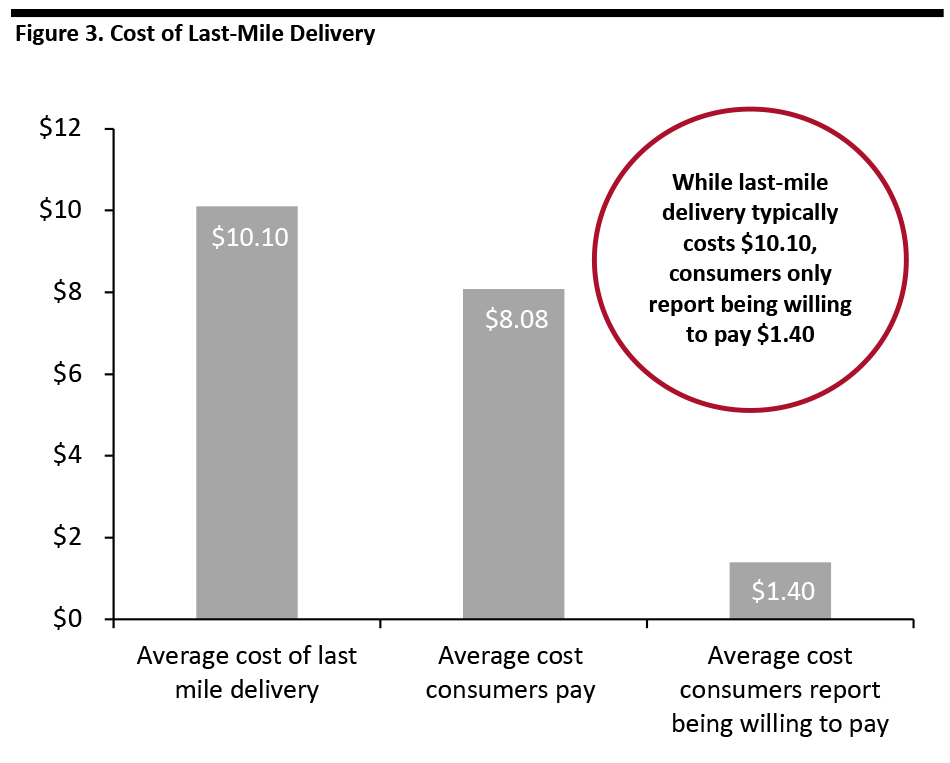 Source: Capgemini Research Institute [/caption]
Drop shipping has emerged as a potential solution to mitigating logistics costs in a retail world that is increasingly dependent on fast, cost-effective delivery. The model enables large suppliers and smaller retailers to work together to eliminate unnecessary shipment costs. Instead of shouldering the cost of two deliveries (one to the store and one to the end consumer), suppliers and retailers can split the costs of one direct shipment to the consumer. Furthermore, retailers can reduce warehousing and storage costs by reducing the amount of inventory they hold at any given time.
Drop shipping has already taken hold in the Asia-Pacific region, which currently makes up 31.9% of the worldwide drop-shipping market, according to Research and Markets. While the US has not seen adoption of drop shipping as widespread, it too is expected to see rapid growth in drop shipping over the next few years. The global drop-shipping market was valued at $162 billion in 2019 and is expected to reach $592 billion by 2027, according to Research and Markets—representing a CAGR of 18.3%.
2. Optimizing Order Fulfillment To Reduce Costs and Friction
Beyond a simple presence across shopping platforms, retailers must also ensure that purchases can be fulfilled cost-effectively and quickly across channels. According to SalesCycle, 88% of global online shopping carts were abandoned in March 2020. As highlighted in Figure 4, the most common reasons that consumers abandon their online shopping carts are high extra checkout costs and difficulties in the purchasing process.
[caption id="attachment_120139" align="aligncenter" width="700"]
Source: Capgemini Research Institute [/caption]
Drop shipping has emerged as a potential solution to mitigating logistics costs in a retail world that is increasingly dependent on fast, cost-effective delivery. The model enables large suppliers and smaller retailers to work together to eliminate unnecessary shipment costs. Instead of shouldering the cost of two deliveries (one to the store and one to the end consumer), suppliers and retailers can split the costs of one direct shipment to the consumer. Furthermore, retailers can reduce warehousing and storage costs by reducing the amount of inventory they hold at any given time.
Drop shipping has already taken hold in the Asia-Pacific region, which currently makes up 31.9% of the worldwide drop-shipping market, according to Research and Markets. While the US has not seen adoption of drop shipping as widespread, it too is expected to see rapid growth in drop shipping over the next few years. The global drop-shipping market was valued at $162 billion in 2019 and is expected to reach $592 billion by 2027, according to Research and Markets—representing a CAGR of 18.3%.
2. Optimizing Order Fulfillment To Reduce Costs and Friction
Beyond a simple presence across shopping platforms, retailers must also ensure that purchases can be fulfilled cost-effectively and quickly across channels. According to SalesCycle, 88% of global online shopping carts were abandoned in March 2020. As highlighted in Figure 4, the most common reasons that consumers abandon their online shopping carts are high extra checkout costs and difficulties in the purchasing process.
[caption id="attachment_120139" align="aligncenter" width="700"]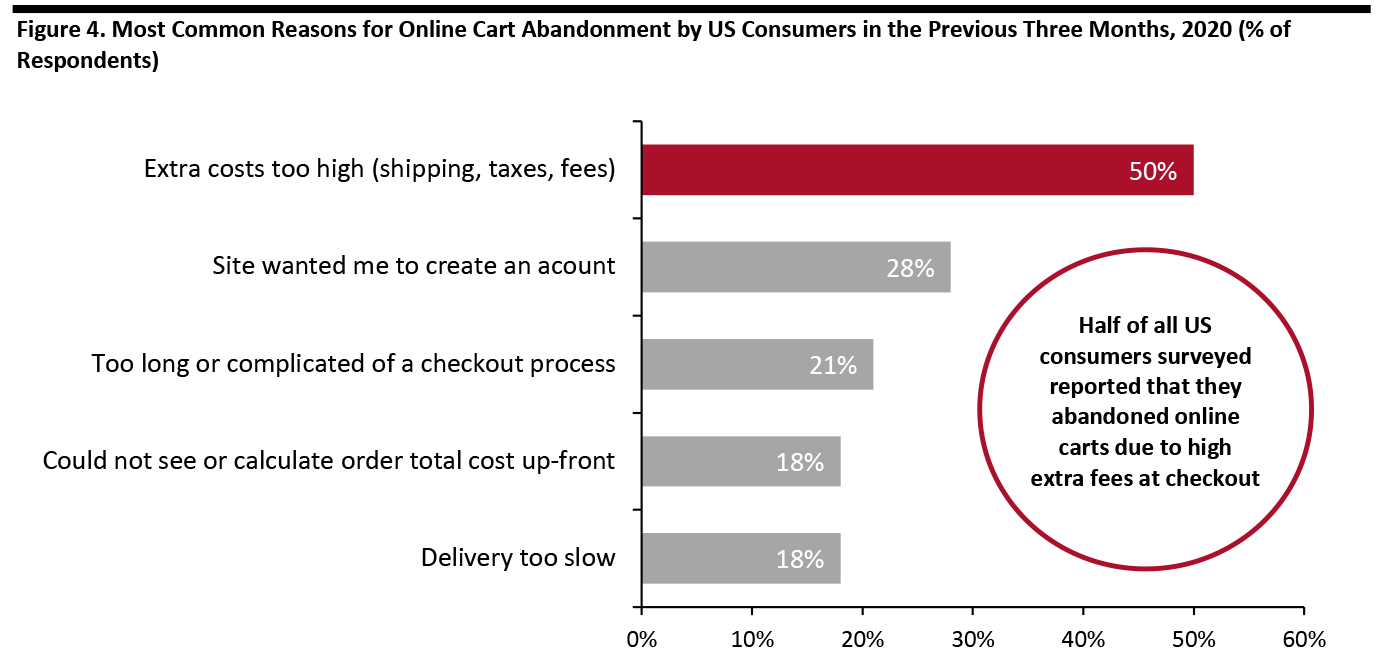 Source: Baymard Institute[/caption]
Delivery remains a common pain point in online commerce for brands. As Figure 4 indicates, 50% of online cart abandonments are due to unexpected costs at checkout, often including delivery charges, according to data from the Baymard Institute. Consumers’ high expectations for timely delivery, shown in Figure 5, can put a strain on smaller brands’ logistics networks and negatively impact their bottom lines.
[caption id="attachment_120140" align="aligncenter" width="700"]
Source: Baymard Institute[/caption]
Delivery remains a common pain point in online commerce for brands. As Figure 4 indicates, 50% of online cart abandonments are due to unexpected costs at checkout, often including delivery charges, according to data from the Baymard Institute. Consumers’ high expectations for timely delivery, shown in Figure 5, can put a strain on smaller brands’ logistics networks and negatively impact their bottom lines.
[caption id="attachment_120140" align="aligncenter" width="700"]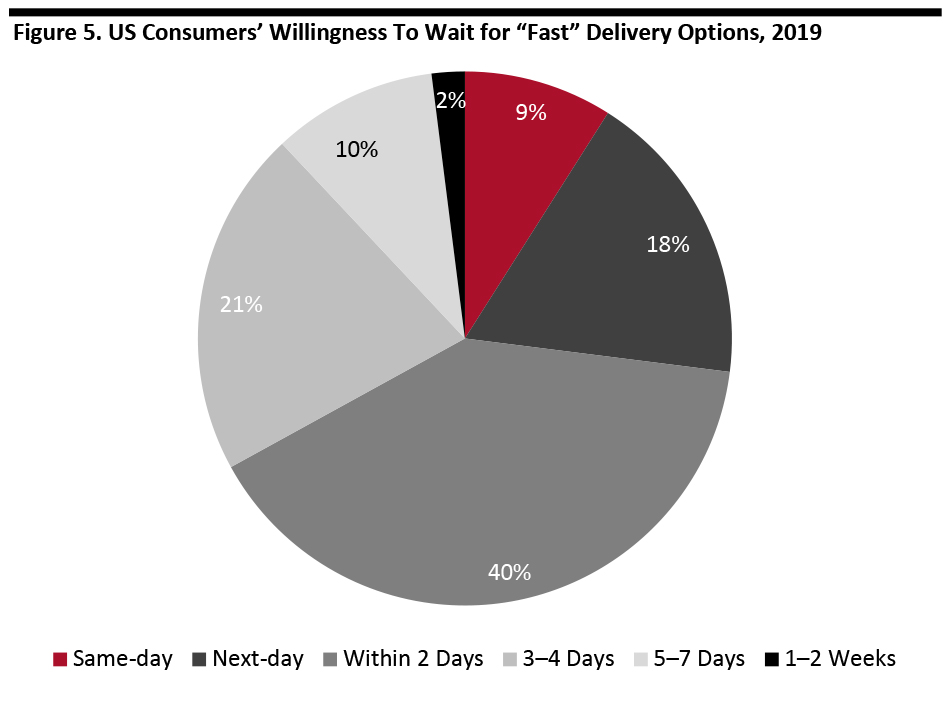 Source: Deloitte [/caption]
Today, delivery challenges have been compounded by capacity constraints brought on by increased online demand and shipment issues amid the Covid-19 pandemic. Delivery companies FedEx and UPS have warned of shipment slowdowns, and they are facing particular challenges in next-day shipping due to the drastic reduction in air-cargo capacity. This holiday season will likely put an additional strain on shipment resources as consumers gear up to shop more online.
An increase in online order activity may also lead to challenges with inventory assortment, planning and replenishment. Sellers often do not have the correct inventory in the right location to offer fast and affordable deliveries, which oftentimes results in a choice of incurring higher fulfillment costs or passing on those added costs to the customer and contributing to the rise cart abandonment rates.
Amazon reported during the early days of the crisis that it would hire 100,000 more warehouse and delivery workers to cope with the increase in online orders. However, most brands do not have the necessary pocketbooks or facilities to make such large-scale capacity increases. Instead, working with a capable third-party fulfillment provider that has experience and processes for ramping up for peak volumes and then scaling back down can enable brands to adjust for changing demand, such as what we are experiencing with Covid-19 and the traditional peak holiday season.
Source: Deloitte [/caption]
Today, delivery challenges have been compounded by capacity constraints brought on by increased online demand and shipment issues amid the Covid-19 pandemic. Delivery companies FedEx and UPS have warned of shipment slowdowns, and they are facing particular challenges in next-day shipping due to the drastic reduction in air-cargo capacity. This holiday season will likely put an additional strain on shipment resources as consumers gear up to shop more online.
An increase in online order activity may also lead to challenges with inventory assortment, planning and replenishment. Sellers often do not have the correct inventory in the right location to offer fast and affordable deliveries, which oftentimes results in a choice of incurring higher fulfillment costs or passing on those added costs to the customer and contributing to the rise cart abandonment rates.
Amazon reported during the early days of the crisis that it would hire 100,000 more warehouse and delivery workers to cope with the increase in online orders. However, most brands do not have the necessary pocketbooks or facilities to make such large-scale capacity increases. Instead, working with a capable third-party fulfillment provider that has experience and processes for ramping up for peak volumes and then scaling back down can enable brands to adjust for changing demand, such as what we are experiencing with Covid-19 and the traditional peak holiday season.
Challenges and Opportunities in Unified Commerce
Given this growth in new channels and the pertinence of optimizing fulfillment, brands must navigate a complex mix of e-commerce opportunities and challenges associated with both owned and third-party s sales channels. In order to have a comprehensive e-commerce ecosystem of selling channels, most brands must sell on marketplaces as well as through their owned websites and apps. They must also carve out a presence on social media channels, by selling directly through social platforms and by directing traffic to their sites via promotions. Finally, brands must increasingly leverage retail drop shipping as a method of selling directly to consumers while simplifying the fulfillment process. Figure 6 illustrates the comprehensive online ecosystem that successful brands embrace to optimize their e-commerce business. [caption id="attachment_120141" align="aligncenter" width="700"]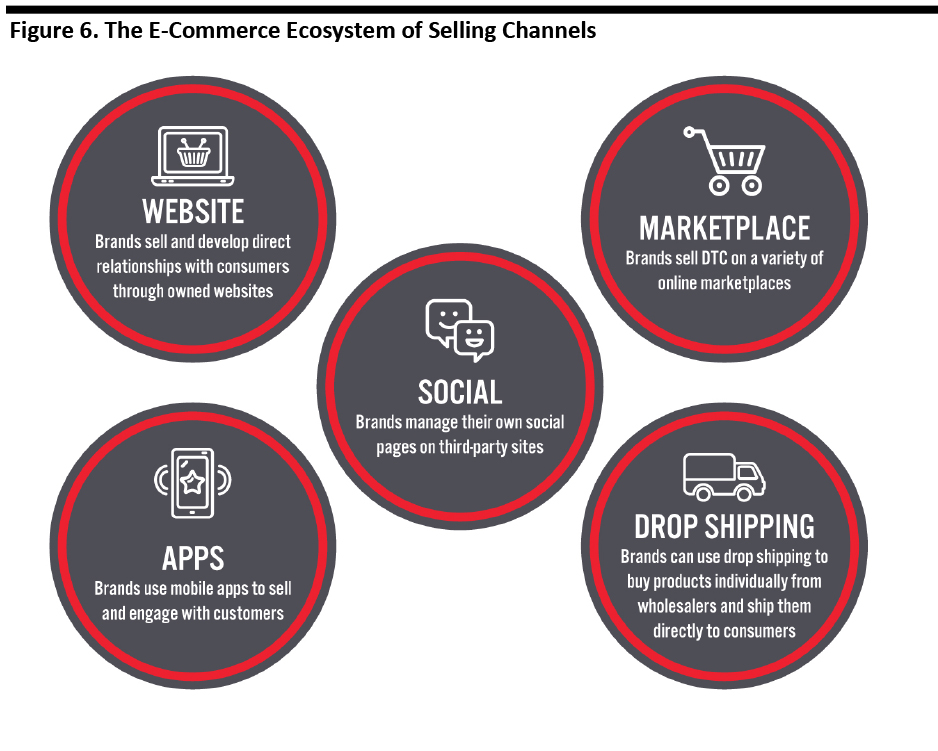 Source: Coresight Research[/caption]
Brands can struggle to sell effectively across each of these channels, often due to an inability effectively manage all of their marketing and sales channels and difficulties in optimizing integrated inventory management and fulfillment across those channels. Coresight Research has identified three opportunities for brands to expand and optimize their online presence:
Source: Coresight Research[/caption]
Brands can struggle to sell effectively across each of these channels, often due to an inability effectively manage all of their marketing and sales channels and difficulties in optimizing integrated inventory management and fulfillment across those channels. Coresight Research has identified three opportunities for brands to expand and optimize their online presence:
- Reach consumers where they are. To optimize their online business, brands need to ensure they are present across each selling channel in the e-commerce ecosystem.
- Diversifying sales channels: Brands should focus on leveraging large marketplaces such as Amazon and Walmart, while also investing in their DTC operations.
- Optimize logistics operations. Brands can leverageartificial intelligence (AI) and machine learning to streamline and integrate inventory planning and replenishment, as well as multi-location order management across selling channels—enabling faster, cheaper shipping.
Project Verte: End-to-End Solutions for Unified Commerce
Project Verte is an end-to-end solution for brands looking to grow their online sales. The platform helps brands optimize their online business and consolidate all selling channels, supply and demand into one data-driven ecosystem. In this section, we outline how Project Verte can enable brands to take advantage of the opportunities for growth in the e-commerce ecosystem, outlined in the previous section. Project Verte Platform Features Project Verte’s platform offers clients the following features:- Seamless integration and catalog publishing across online channels
- Multi-site order flow and visibility
- Inventory planning and replenishment
- Transportation management
- Nationwide network of fulfillment centers
- Comprehensive seller platform operating system for end-to-end control and visibility
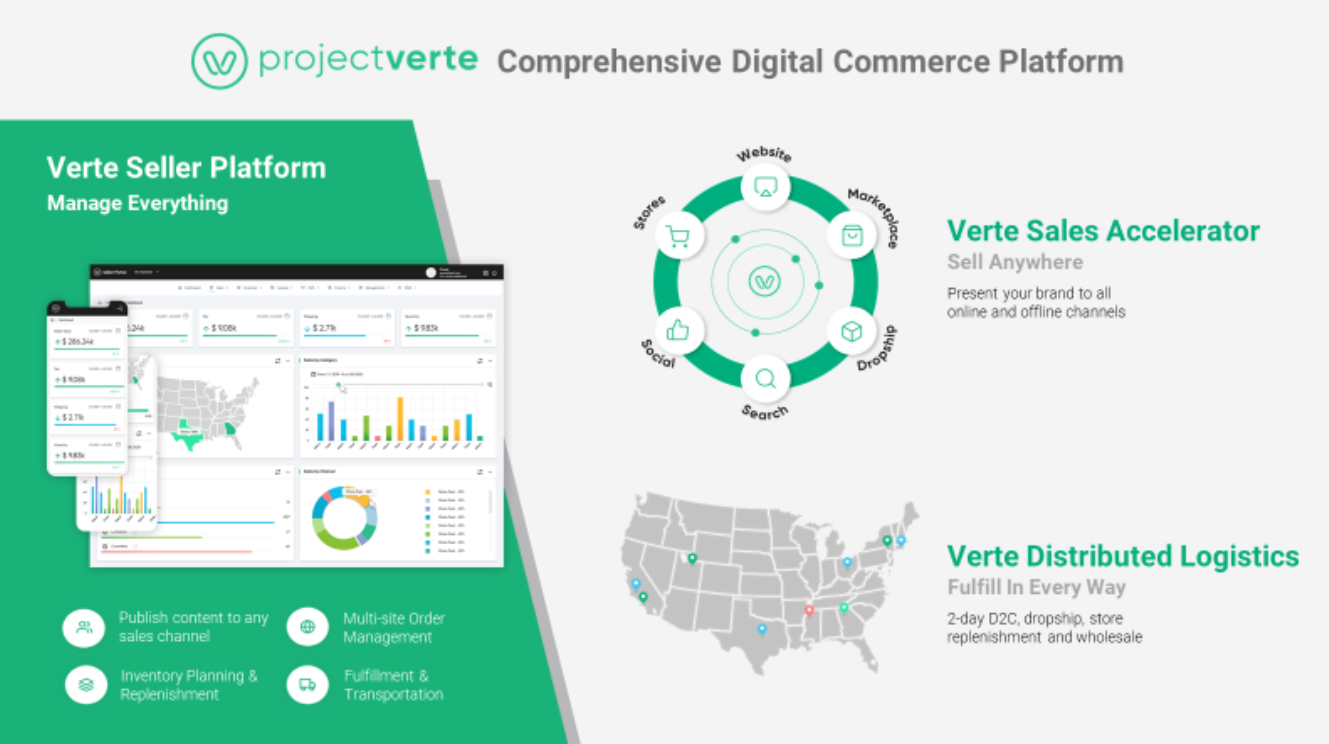 Source: Project Verte [/caption]
Source: Project Verte [/caption]
Key Competitive Advantages
Below, we highlight two of Project Verte’s key competitive advantages, focusing on how the company enables brands to optimize the end-to-end operations of their online business. 1. Enabling Retailers To Provide a Seamless and Branded Customer Journey Across Channels Project Verte’s leading value-add is its capability to enable brands to “sell anywhere” through the Verte Sales Accelerator. As consumers are increasingly shopping across different channels—including marketplaces, social media shopping, drop-ship and owned domains—brands are increasingly challenged to develop channel specific content and manage their catalogs across sales avenues. The Verte Sales Accelerator enables brands to customize inventory availability by specific channel and process up to 20,000 orders per second across channels. Through Project Verte’s systems, brands can greatly reduce costs associated with inventory management and online content development by automating time-consuming tactical tasks, reducing headcount and improving efficiency. The Verte Sales Accelerator is also a revenue driver. By managing a brand’s engagement across multiple channels, Project Verte can not only save their clients money on platform management but can also use its AI- and analytics-powered systems to drive revenue growth. The Verte Sales Accelerator identifies growth opportunities in real time and uses its AI engine to enable brands to make real-time adjustments to their inventory management and pricing. The system can help brands improve their profitability by generating improved margin insights, along with dynamic pricing adjustments. [caption id="attachment_120143" align="aligncenter" width="700"]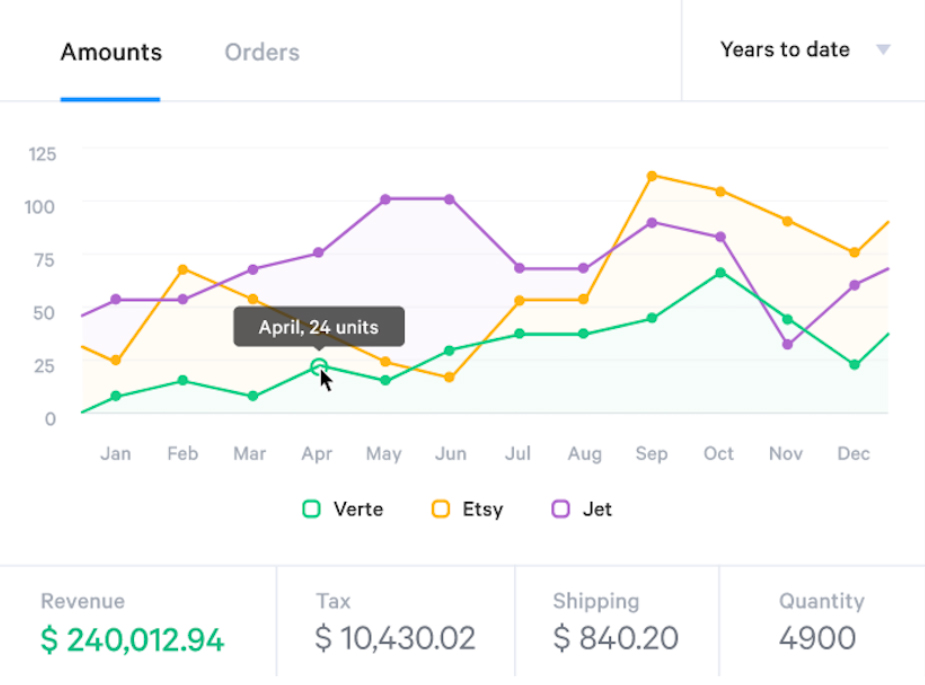 The Project Verte Sell Anywhere dashboard
The Project Verte Sell Anywhere dashboard Source: Project Verte [/caption] 2. Transforming the Supply Chain into a Revenue Generator Project Verte provides inventory management and fulfillment services to its clients, enabling brands to take advantage of e-commerce growth opportunities by optimizing their logistics operations. As consumers increasingly value two-day, next-day and same-day delivery, it can be difficult for brands to find both cost-effective and fast shipment methods. These challenges can cost brands time, money and customers: Delivery fees and speed continue to be common reasons for cart abandonment. Project Verte helps brands meet these challenges in two interconnected ways. The company has a network of fulfillment centers beyond the scope of what most brands can sustain in their own direct-to-consumer (DTC) operations, with the following features:
- A nationwide network of fulfillment centers with both ambient facilities for general merchandise and temperature-controlled facilities for food and beverage products.
- A flagship 750,000-square-foot, fully automated fulfillment center in Atlanta. All fulfillment centers are capable of complete omnichannel functionality to include DTC, retail replenishment and wholesale.
- All facilities are connected through the Verte Distributed Logistics technology that provides a single view and operating platform for all fulfillment activities.
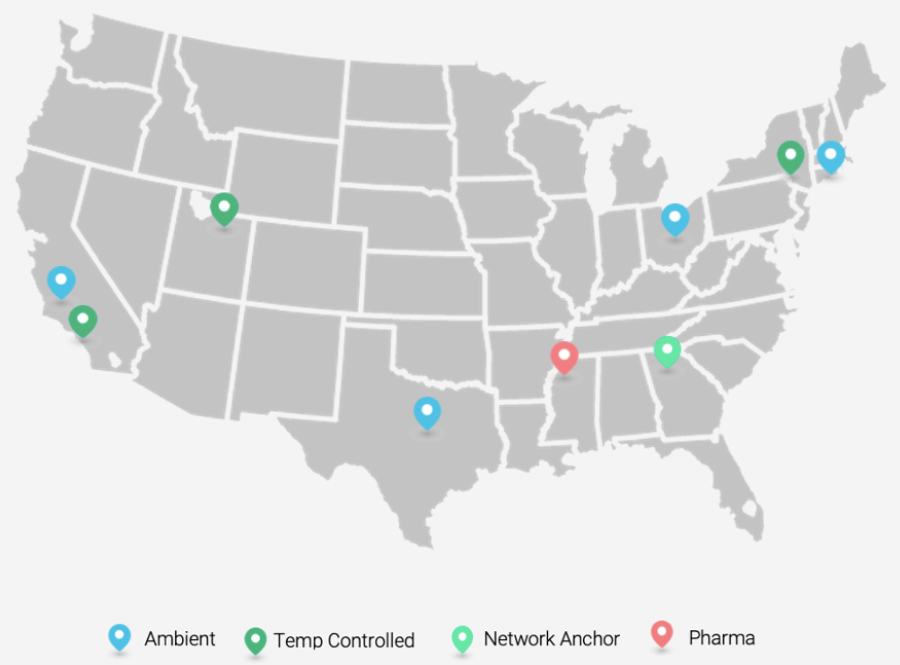 Source: Project Verte[/caption]
The company couples its physical infrastructure with the use of machine learning and AI to manage critical operations such as inventory planning, replenishment and order distribution in a multi-location fulfillment network, which accelerates speed and minimizes total cost. The technological features of Project Verte’s fulfillment solutions provide a number of advantages:
Source: Project Verte[/caption]
The company couples its physical infrastructure with the use of machine learning and AI to manage critical operations such as inventory planning, replenishment and order distribution in a multi-location fulfillment network, which accelerates speed and minimizes total cost. The technological features of Project Verte’s fulfillment solutions provide a number of advantages:
- Brands can seamlessly connect and manage inventory to all online sales channels.
- The company’s fully automated fulfillment centers provide omnichannel capabilities through application specific warehouse automation systems that are designed to optimize operations for DTC, store replenishment and wholesale.
- Project Verte uses its Distributed Order Management System (DOMS) to optimize fulfillment. DOMS uses data on the location of inventory, the level of service that has been committed to it and where the online order is being placed to determine the most efficient location and method of fulfillment.
- Flexibility—Brands can start with on-location fulfillment and add facilities in their network as they grow or as requirements change. Network locations are capable of the most challenging product requirements, such as temperature-controlled fresh and frozen, as well as fully compliant handling for health and medical products.
- Automation—Automated facilities are designed to deploy technology where it has the most impact. Handing automation systems will be used to optimize DTC, store replenishment and wholesale. Automation also reduces the need for associates and facilitates socially distant work processes for safety amid Covid-19.
- Integrated Solutions—These physical capabilities, combined with inventory planning, order management and sales channel integration, provide for a unique, full-circle, end-to-end solution.
- Cost—The combination of industry leading technology and the efficient nationwide physical infrastructure provides brands the highest capability levels at dramatically reduced costs.
Coresight Research’s View
As e-commerce continues to grow as a percentage of all retail sales, and consumers shop across multiple channels and become more demanding, we identify three areas of opportunity for brands to improve their online offerings:- Reach channel-agnostic consumers acrossthe e-commerce ecosystem.
- Diversify sales channels by focusingon leveraging large marketplaces such as Amazon and Walmart, while also investing in their DTC operations.
- Optimize fulfillment and inventory management with machine learning and AI technology that can create smarter logistics networks and grow revenue by appealing to the increasingly impatient and friction-intolerant consumer.